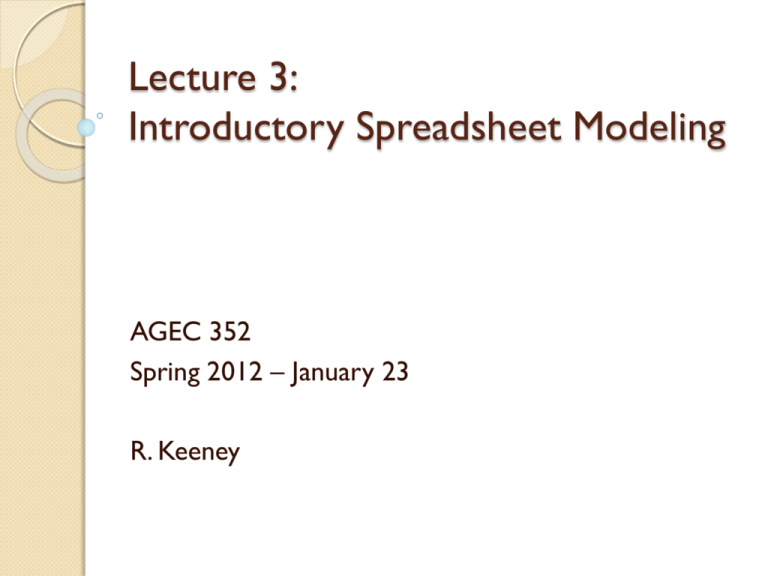Price
advertisement

Lecture 3: Introductory Spreadsheet Modeling AGEC 352 Spring 2012 – January 23 R. Keeney Material to Date Review of mathematics and economics and introduced optimization Relating the algebra and calculus we have seen in previous courses to the economic principles from previous courses ◦ This is a general pattern for this course factoring in that most of the math we do shows up in spreadsheet formulae Spreadsheet Modeling Ways to think of it… Miniature, reduced, simplified version of an economic problem A firm plans… ◦ ◦ ◦ ◦ ◦ ◦ Production schedule Purchase and sale activities (inputs and outputs) Cost and inventory management Transfers within company Marketing and promotion Managerial and labor assignments Basics Identification of the management problem ◦ Must be clearly specified ◦ Goal of modeling is not to ‘solve’ the problem— rather to guide decision making Given the management problem ◦ Identify the management objective ◦ Identify the choice(s) under management control ◦ Identify other variables not under management’s control Other steps as we advance in class Price setting example (1/18) What price to charge to earn highest profit? Under the firm’s control: Price Firm’s objective: Maximum Profits Not under the firm’s control ◦ Everything else… Demand (intercept and slope of equation) Cost function (intercept and slope of equation) Map the Problem Out Maximum Profits What comes in between? Price Charged by Firm Map the Problem Out Maximum Profits Costs Revenue Price charged affects revenue (P x Q) Does price charged affect costs? C = ??? Price Charged by Firm Map the Problem Out Maximum Profits Revenue Quantity Costs minus multiply Price Fixed Costs plus Variable Costs Price Charged by Firm Map the Problem Out Maximum Profits Revenue Q = a + bP Costs minus multiply Price Fixed Costs plus VC = Q x U Price Charged by Firm Map the Problem Out Maximum Profits Revenue Q = a + bP Costs minus multiply Price Fixed Costs plus VC = U x (a + bP) Price Charged by Firm Summary Firm sets a price to influence profits The price chosen influences ◦ Quantity sold as determined by demand curve ◦ Revenue due to price and the quantity sold ◦ Costs through variable costs and the quantity sold Not of the firm’s control: ◦ Demand curve numbers ( a and b) ◦ Cost curve numbers (Fixed costs, U) Classification Free/choice variable: price ◦ Firm can set any value it wants Consequence variable: quantity, variable costs, profits ◦ The value depends on the choice of the firm and some values not under its control Parameter (exogenous variable): demand curve intercept and slope, fixed costs, unit cost of production ◦ These values are given and do not change when the firm changes its choices Building a spreadsheet model Labeling ◦ Every value entered into a spreadsheet needs an accompanying label Easy to find Clearly identifies what the cell entry is Formula linkages ◦ Every calculation in a spreadsheet needs to be attached to the simplest accurate formula E.g. quantity instead of the full demand calculation Parameter specification ◦ Every parameter (fixed number value) that is part of a formula needs to be entered into its own cell Model Results: What is different about each section? Consequence Variables Profits ($) Revenue ($) Costs ($) Quantity (units) -15 0 15 10 -5 9 14 9 3 16 13 8 9 21 12 7 13 24 11 6 15 25 10 5 15 24 9 4 13 21 8 3 9 16 7 2 3 9 6 1 -5 0 5 0 Parameters Demand Intercept Demand Slope Fixed Costs ($) Variable Cost per Unit 10 -1 5 1 10 -1 5 1 10 -1 5 1 10 -1 5 1 10 -1 5 1 10 -1 5 1 10 -1 5 1 10 -1 5 1 10 -1 5 1 10 -1 5 1 10 -1 5 1 0 1 2 3 4 5 6 7 8 9 10 Choice Variables Price ($) Graphical Analysis Dollars (revenue, cost) 30 25 20 15 10 5 0 0 2 4 6 Price Charged by Firm Revenue ($) Costs ($) 8 10 Modeling to help decisions We said a model is a simplification of a management/economic problem What do we do with it? ◦ We’ve seen how it guides price setting What else? ◦ Management/planning questions Model as a lab Another way to think of an economic model is as a laboratory for doing experiments or scenarios ◦ (some textbooks call this ‘what if’ analysis) Unlike physical sciences, it is rare to see experimental trials in economics ◦ Agents like to earn on resources, not randomize decisions to see which one emerges as best… Model utility Just like in lab experiment settings, models of economic situations are only as useful as their proximity to actual conditions Difficulties ◦ Many interconnected decisions and relationships at work ◦ Rely on historical data to express relationships in the future Lab tomorrow Handout will be posted on class website by 10 AM. We’ll use Blackboard Discussion ◦ 1) Discussion forum is linked from the blackboard page for this class ◦ 2) Sign in by replying to the sign-in topic ◦ 3) Instructor questions will be posted between 10:50 and 11:00. If I am calling on you, your name will be in the subject line…






